Truck Camper Magazine explores Supertramp Campers in Golden, Colorado and finds a young team focused on cutting-edge technology, precision manufacturing, and top-secret proprietary processes. But the real Supertramp ‘Secret Sauce’ is…

When we interviewed Kelsey Panich, Supertramp’s Chief Operations Officer, for the company’s TCM debut last November, every answer had us leaning further forward. From boldly embracing advanced technology to pioneering new manufacturing processes to fostering a progressive team culture, Supertramp’s vision became increasingly clear. Supertramp wasn’t your typical start-up camper company. Supertramp was a laser-focused team on a mission.
Six months later, we rolled into Supertramp in Golden, Colorado to experience the company first hand. For the better part of three days, we studied their advanced materials, observed their technologies, learned about their processes, and absorbed as much of their team culture as possible. It was a lot to take in, and a lot of fun.
Before we started, we asked Kelsey and Co-Founder, Keith Panich, if there was anything off-limits for our photography or reporting. This is our standard approach to any factory we tour usually resulting in a short list of items that need to stay off-the-record. After all, it’s a big ask to get the full and unsupervised run of a factory to take pictures, ask questions, and generally be nosey journalists.
It was then that we learned that Supertramp had never allowed outside media to document, much less photograph, their factory and process. As Keith explained it, the design, development, and prototyping of Supertramp’s Flagship LT and Megatron took an enormous amount of time, effort, and financial cost to achieve. He called the sum total of this investment Supertramp’s ‘Secret Sauce’ and asked that we not to reveal the more sensitive aspects of the process.
We were honored to be entrusted with this task and agreed to embargo anything they deemed a trade secret. Even with this restriction, Keith and Kelsey allowed us an extraordinary amount of unfettered access and gave us permission to share the majority of their factory and production.
Besides, the real Supertramp ‘Secret Sauce’ has nothing to do with their cutting-edge technology or vacuum-infused fiberglass. There’s something much more important that makes Supertramp who and what they are. Let the positive vibes begin…
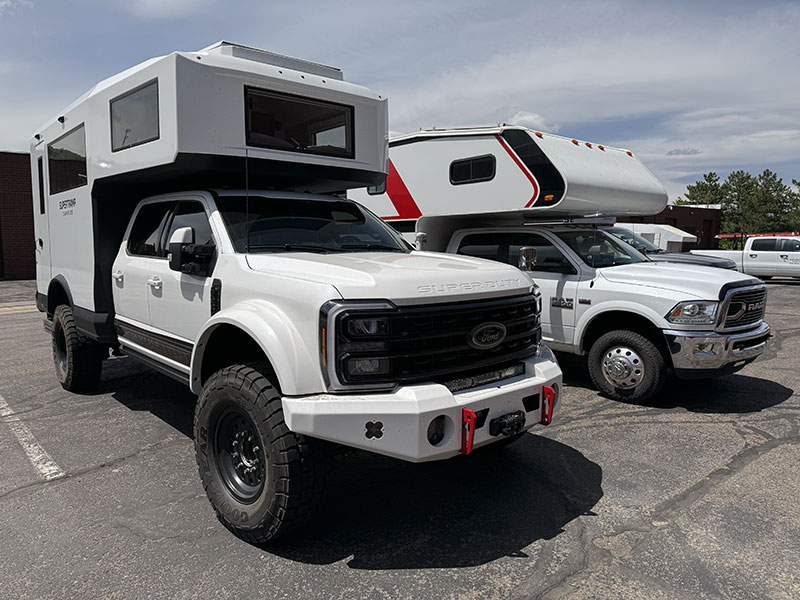
Supertramp’s Megatron chassis-mount beast (above left) was an indisputable stand-out of Overland Expo West 2024, if not the hit of the entire show. When Keith Panich pulled the showstopper next to our truck camper rig at Supertramp, I couldn’t resist the photo opportunity. One of these days it would be fun to do a throw-down compare and contrast showdown—Megatron chassis-mount vs. demountable truck and camper. Go!
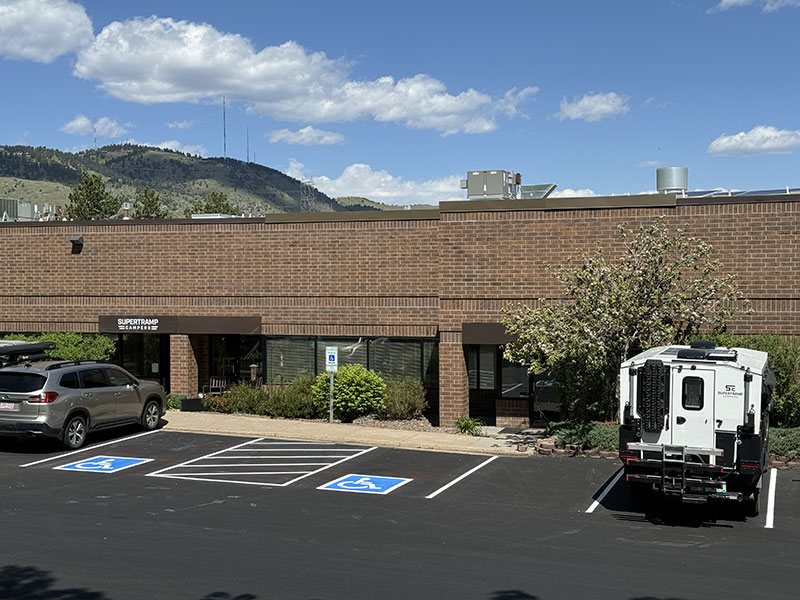
Most camper manufacturers are located in decidedly non-corporate settings, outside of a small town, and, nine times out of ten, within a rock’s throw of an active train line.
In contrast, Supertramp HQ is located in a corporate business park alongside software development, engineering, and medical supply firms. Don’t they know this is in violation of Truck Camper Factory Location Rule 8.6 907-B? Yes, they do.
Supertramp is undoubtedly paying significantly more rent than their fellow camper manufacturers, but their location choice is entirely on purpose. As Keith and Kelsey explained it, Supertramp needs to be located where their employees want to live. Put another way, they prioritized their team’s quality of living over overhead. As this factory tour unfurls, this team-first focus will repeat itself again, and again.
The Supertramp facility is actually split between two corporate suites located about five minutes walking distance apart. The first suite (shown above) is where the vacuum-infused fiberglass shells and other camper components are made. The second suite is where these items are assembled into finished Flagship LT or Megatron units. During the course of documenting our tour, we got quite the workout commuting from one location to the other.
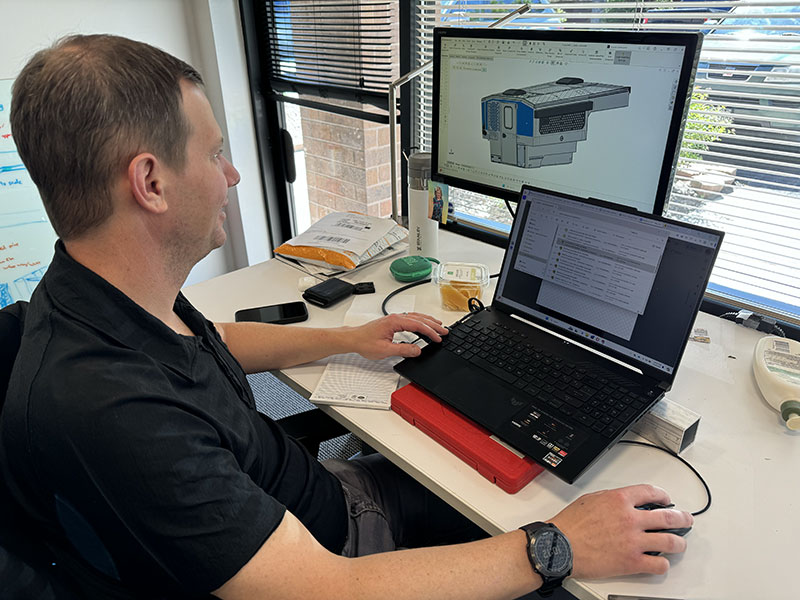
Right before our visit, Supertramp expanded its first suite location to include the suite next door. This added several new spaces that were becoming the new offices for engineering, storage, and 3D printers.
In the image above we see Matt showing us a 3D Solidworks model of a Supertramp Flagship LT. Matt previously founded and operated an advanced composite bicycle company. His experience with computer-aided design, composite material science, and precision manufacturing were all highly applicable to Supertramp.
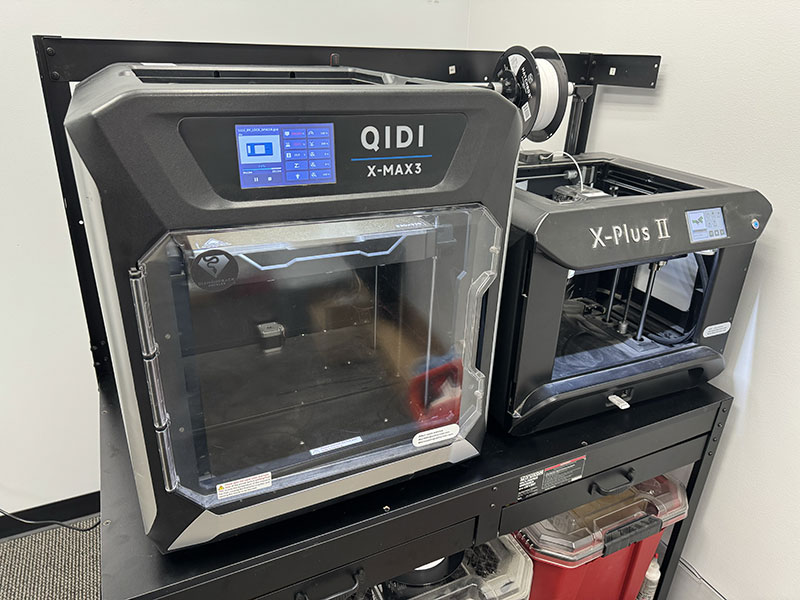
In an adjacent office, two Qidi Tech 3D printers operate nearly 24/7 creating critical parts for Supertramp campers. The team explained that the 3D printing equipment and technology were rapidly advancing bringing more and more possibilities to the table. The larger X-Max 3 pictured above can print at speeds up to 600 millimeters per second.
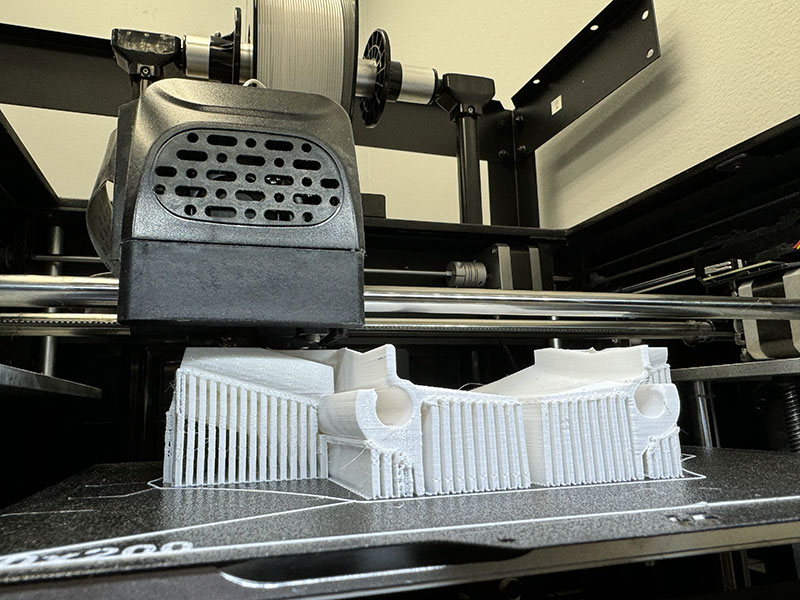
The 3D printers are making custom parts that would be cost-prohibitive to manufacture by traditional injection molding. Here we see a bracket used for Flagship LT soft walls.
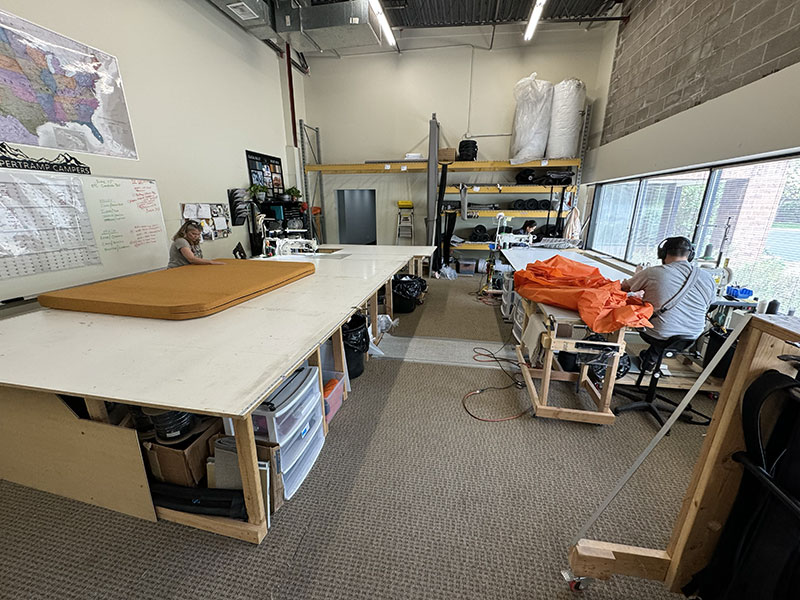
Just inside the front door of the first suite is where we found Supertramp’s three person sewing team. Supertramp designs and manufactures all of their soft walls and cushions in-house. In fact, Supertramp makes a point to design and manufacture nearly every aspect of their finished campers in-house.
The three Kingmax machines piloted by the sewing team are specifically designed for industrial applications and can handle the multiple layers of heavy-duty synthetic materials required to build a Supertramp soft wall.
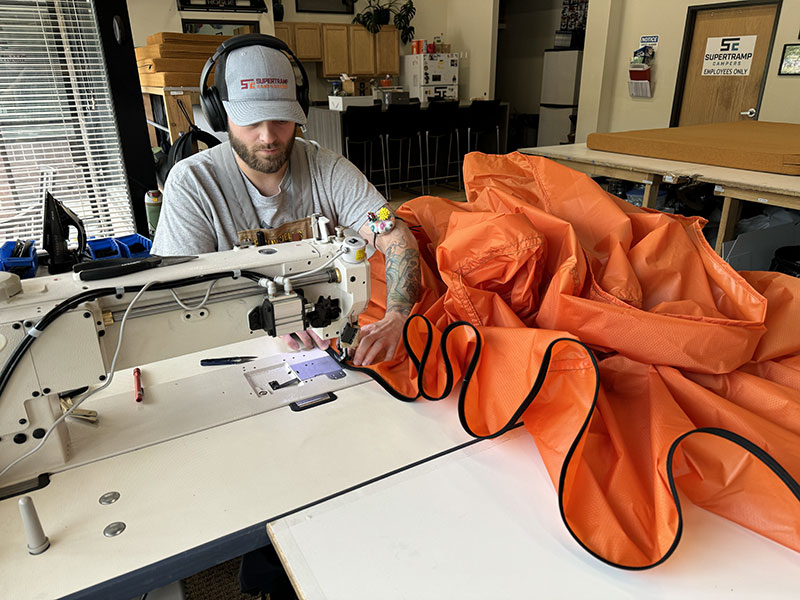
While making a Desert Mesa shower curtain for a Flagship LT, Adrian explained to us how he loves the flexible hours and overtime options offered by Supertramp. He’s used the flextime to adjust his work schedule around family events and worked overtime to earn extra pay for vacations and big purchases. We heard similar praise for Supertramp’s work policies from many team members during our visit.
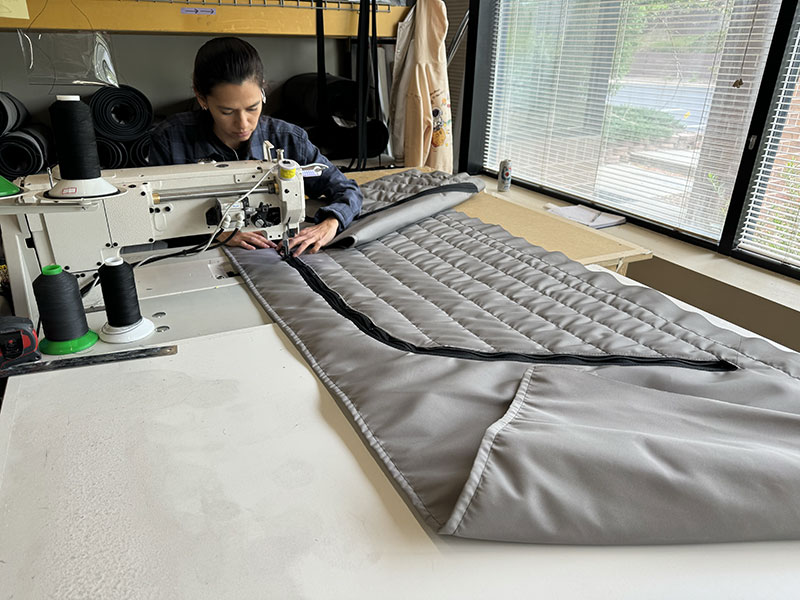
Across from Adrian, Karen was sewing a window seam on a Flagship LT soft wall. It turns out that the three-person sewing team likes to listen to different things as they work. Supertramp soft walls are likely to be sewn to music while cushions are likely to be stitched to an audio book.
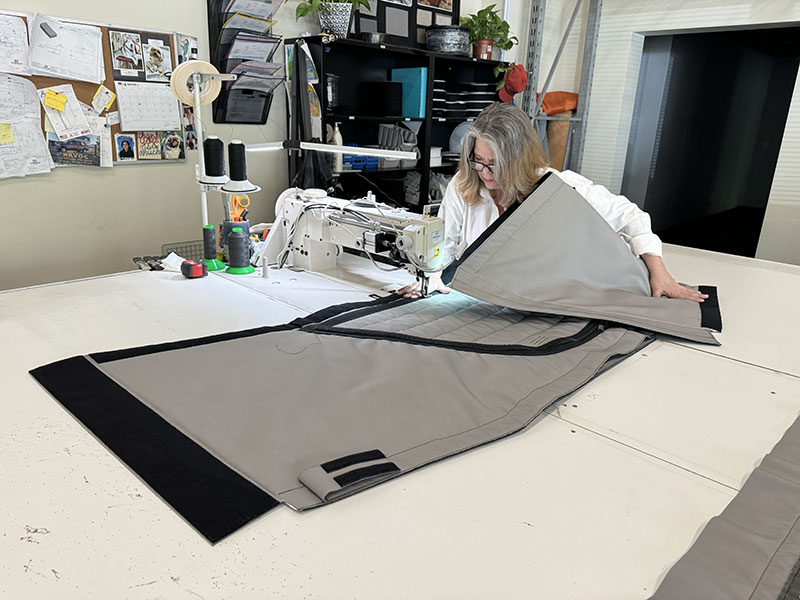
Juls shared with us her years of professional experience working with ultra high-end interior designers and how she brought that level of acumen and detail to Supertramp. This, she explained, is where the large Supertramp Flagship LT windows and meticulous soft wall craftsmanship originate from.

It’s also where Juls’ attention to detail comes from. Synthetic fabrics that make up a soft wall are prone to fray if cut with a metal knife or scissors. To prevent potential fray, Juls uses a tool called a hot knife. With a quick puff of smoke, the edges are sealed.
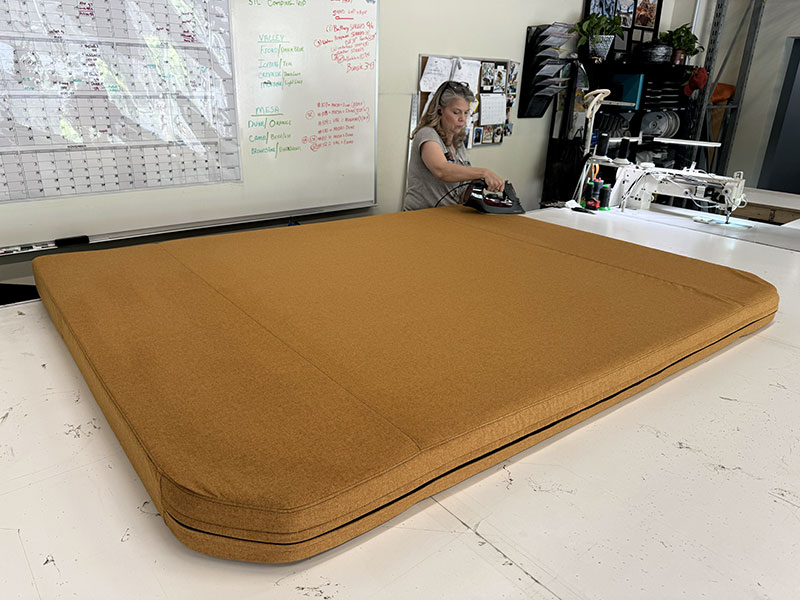
Supertramp offers two interior color palettes; Glacial Valley and Desert Mesa. Within these two interior color palettes, customers can select between four different cushion colors. The Dune cushion shown above is for a Desert Mesa color palette. Note how tight and precise this boxed cushion is.
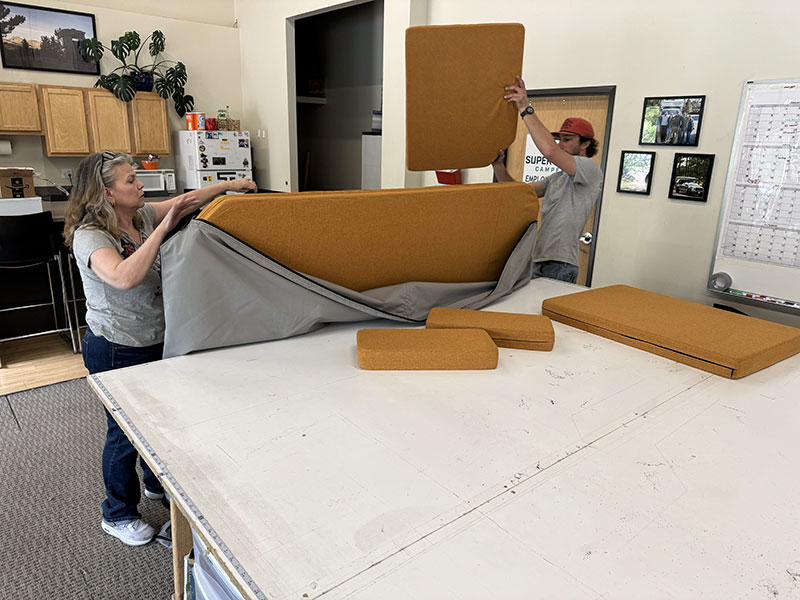
Once a set of cushions is completed, the cushions are zipped into custom-made bags for transport to the second Supertramp suite. The bags keep the cushion sets together and clean during the move. Juls also told us that the cushions are not placed into a camper until the unit is completed and ready for customer delivery.
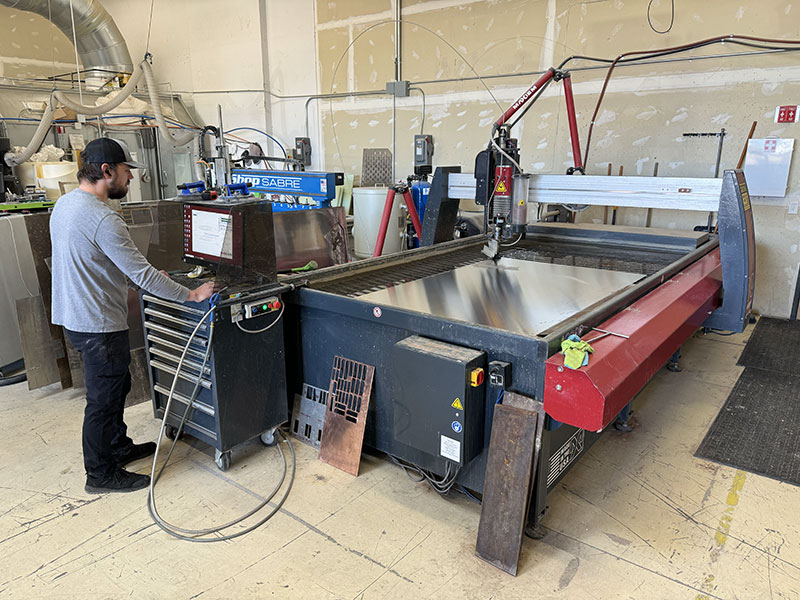
From the sewing area, we passed through a door into the CNC equipment and vacuum-infused fiberglass production area. In the above image, Chad is operating an OMAX Maxiem waterjet (right) and a ShopSabre IS 510 CNC router (left). Between the capabilities of the CNC waterjet and router, there are very few materials Supertramp can’t cut.
Chad operated this equipment like a club DJ moving back and forth between the two CNC tables and computer controls to keep the material production moving. Chad is also responsible for operating the previously shown 3D printers.
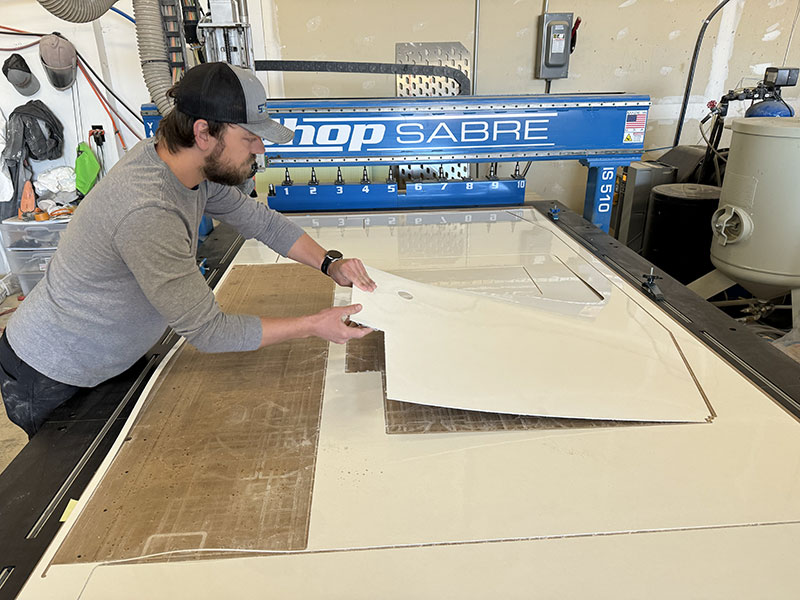
The ShopSabre CNC router features a vacuum table that firmly holds materials down while the 2,100 IPM (inch per minute) cutter quickly, cleanly, and precisely cuts parts. Here you can see the interior back wall of a Supertramp Flagship LT emerging from a sheet of composite.

As we observed the waterjet bubbling a few feet away, a curious sign caught our attention.
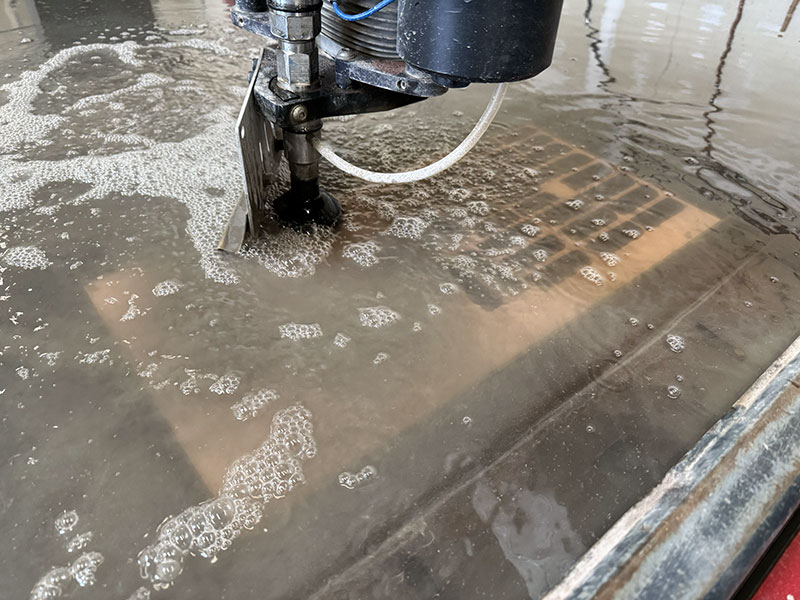
While we refrained from cannonballs and reverse two-and-a-half twists, the waterjet was cutting copper battery connectors for Supertramp’s lithium battery banks.
Chad explained that the waterjet is capable of cutting just about any material they could ever need to work with. With water pressure up to 94,000 PSI, garnet abrasive, and a stream focused to the width of a human hair, the waterjet can cut through quarter-inch stainless steel plate—and beyond. Still want to dive in? No thanks.

While the CNC waterjet and router ran their programs, Chad walked another ten feet to operate an Accurpress CNC press brake.
The part Chad is working on is a new bracket for a Starlink satellite internet system. We later learned that this bracket had been designed earlier that morning and was being prototyped within hours. The technology allowed the Supertramp team to go from concept to CAD to CNC to a functional prototype within a day.
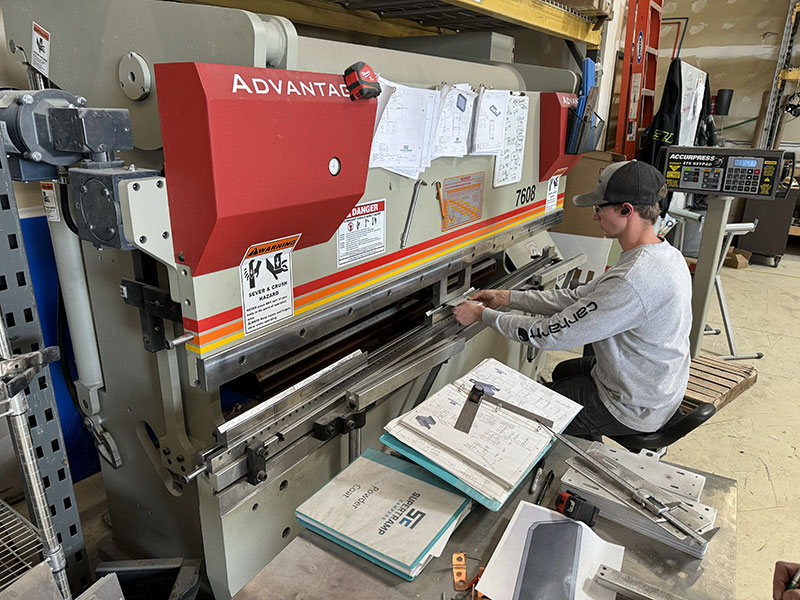
Tom also employed the CNC press brake to bend exterior actuator brackets.
Note the blue binders and digital calipers on Tom’s left. The binders contain the Standard Operating Procedures (commonly referred to as SOPs) for every process of building a Supertramp camper.
We not only found these binders—each labeled for a different manufacturing process or area—throughout Supertramp’s manufacturing facilities, but we also witnessed the team closely referencing these documents during their work. After each part left the press brake, Tom checked it with digital calipers against the stated SOP specification.

Another ten feet past the press brake, Tom welded steel brackets. Observing the team, their extensive capabilities, and on-hand technology, it became increasingly clear that there’s very little that Supertramp can’t design and make in-house.

Above: Austin (left) cuts woven fiberglass for the vacuum-infusion process while Tony (right) tacks the measurement grid
The Flagship LT requires approximately 1,700 strips of fiberglass to make all of its vacuum-infused components. These strips are precisely cut from seven different types of fiberglass, each with their own properties. Once cut and laid into their custom molds, the infusion-fiberglass process is employed with a few proprietary techniques. This is a big part of what Keith and Kelsey refer to as Supertramp’s ‘Secret Sauce’.

As stated in the introduction, Keith was very clear with us that we were not to photograph this process. This is why you won’t see a photograph of Supertramp’s fiberglass molds or their vacuum-infusion techniques. I even handed over my camera to Keith at the end of our three-day visit to make sure nothing proprietary was captured. When Supertramp says, ‘Secret Sauce’, they’re not kidding around.

What we are permitted to show are some of the different closed-cell composite materials they use. Note the different colors indicating different densities and strength-to-weight ratios.
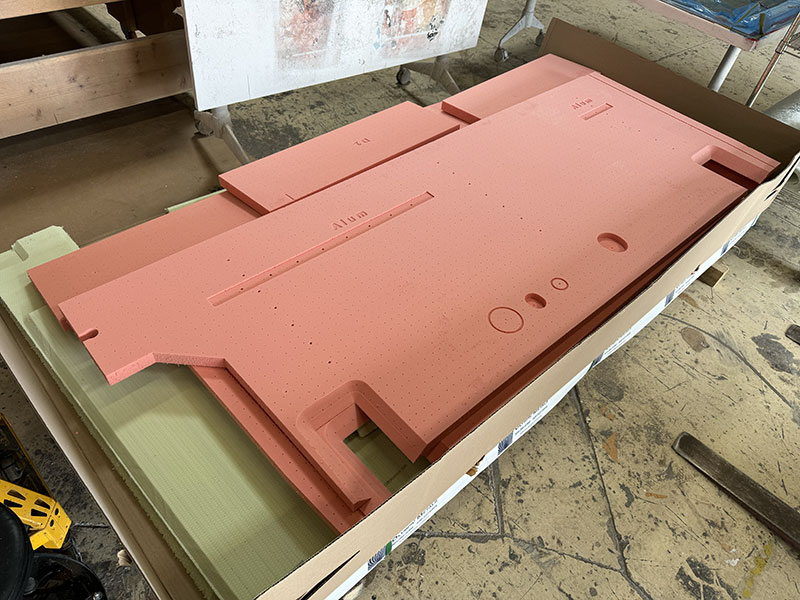
Also, note how the composites are CNC cut, including 45-degree angles, to precisely fit into the molds. Within the layers, the team placed strips of aluminum, G10 high-pressure fiberglass composite, and even carbon fiber for backing and strengthening specific areas.
I was present when the lower camper body fiberglass shell was pulled from its mold. The shell emerged as a seamless fiberglass part. Honestly, it took every ounce of self-control to resist taking a picture. There it was. There I was—holding my camera down by my side. You’ll have to take my word for it. It was beautiful.
This is the moment when all the effort and expense that vacuum-infused fiberglass requires makes perfect sense. The resulting fiberglass shell and components are arguably stronger, lighter, more robust, and more weatherproof than any other camper build approach on Earth.

After the fiberglass parts are pulled, Mike trims and sands the edges. In the above photograph, you can see a freshly trimmed and sanded lower body and the fully enclosed booth beside it. Inside this booth, Mike wears a coverall polypropylene suit, hood, booties, respirator, face mask, rubber work gloves, and hearing protection. Fiberglass may be a superior material for truck camper manufacturing, but it’s not the most friendly to work with.
 Above: Trevor inspects the sanded edges of a Flagship LT lower shell
Above: Trevor inspects the sanded edges of a Flagship LT lower shell
And the fiberglass process doesn’t end there. Once the molds are pulled and trimmed, the parts are sanded, painted, inspected, and—if necessary—sanded, painted, and inspected again until perfect.
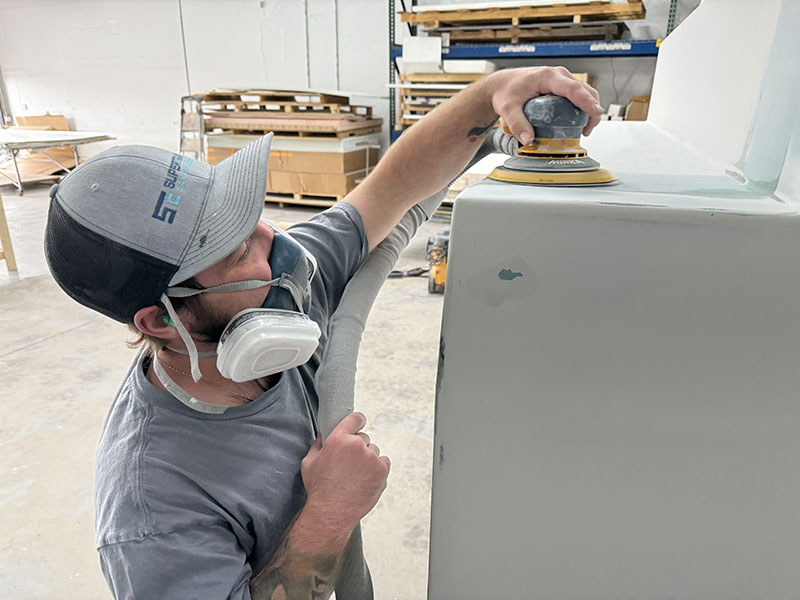
Before working at Supertramp, Trevor worked for companies manufacturing fiberglass and composite wind turbines and aerospace components. What was even more surprising was that several of the team members in the Supertramp fiberglass shop also came from the wind turbine and aerospace industries. Space ships to truck campers? Why not?

Once a part passes its final inspection, it’s moved from the first Supertramp suite to the second Supertramp suite. Some parts, including the roof shown emerging from the paint booth above, are literally wheeled up the street to the assembly line.
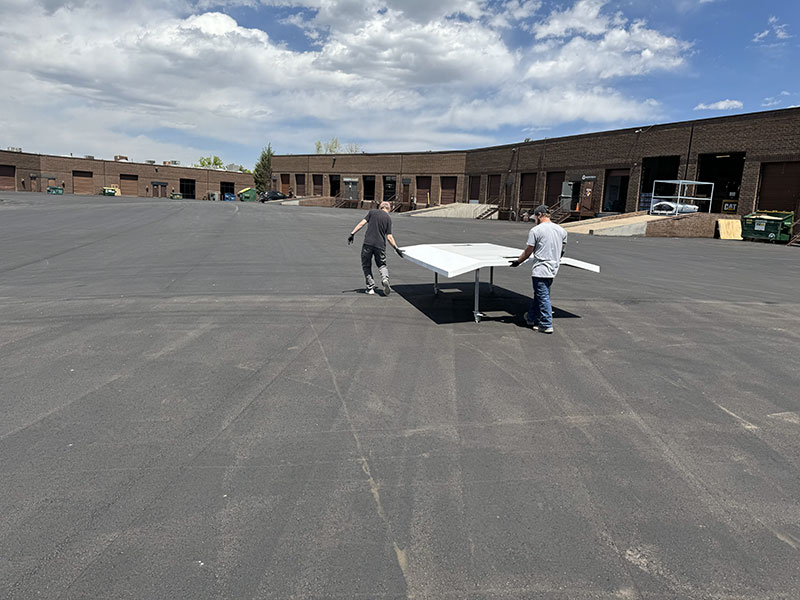
I may not have believed it if I hadn’t seen it with my own eyes, but they literally roll the larger components through the parking lot and up the road to the second suite.
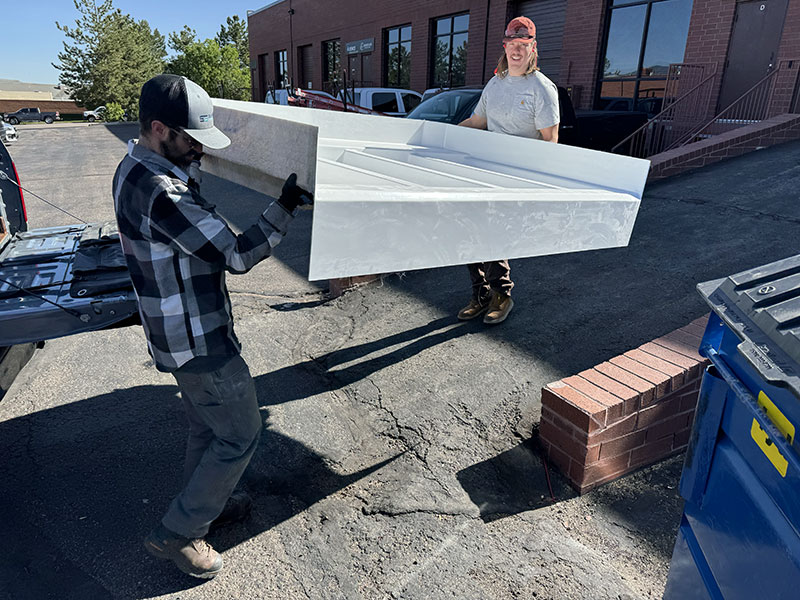
Medium-sized parts are loaded onto trucks and driven to the second suite. Some of the smaller items are delivered by Chad on his Onewheel; a self-balancing, lithium-powered skateboard. Chalk up another industry first for Supertramp.
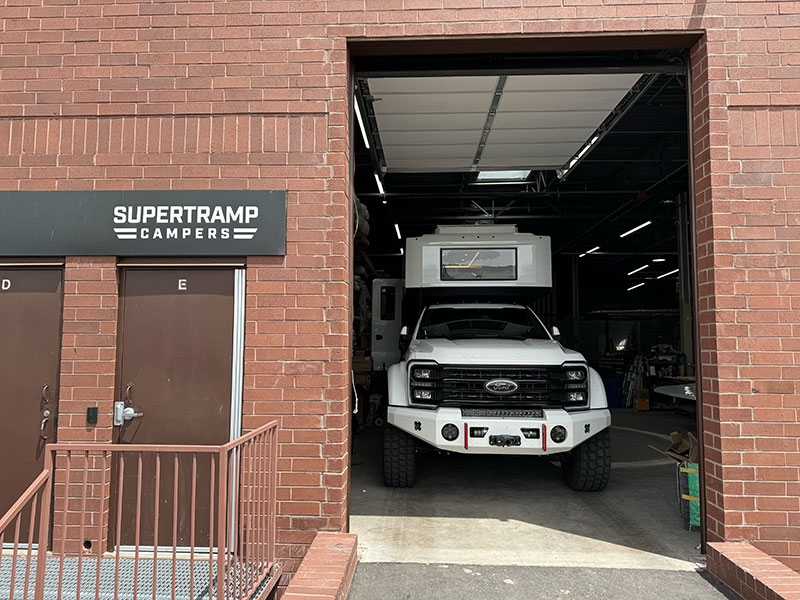
It’s really tough not to take pictures of the Megatron. Shown here inside the bay door of Supertramp’s second suite, Megatron was being cleaned after Overland Expo West.
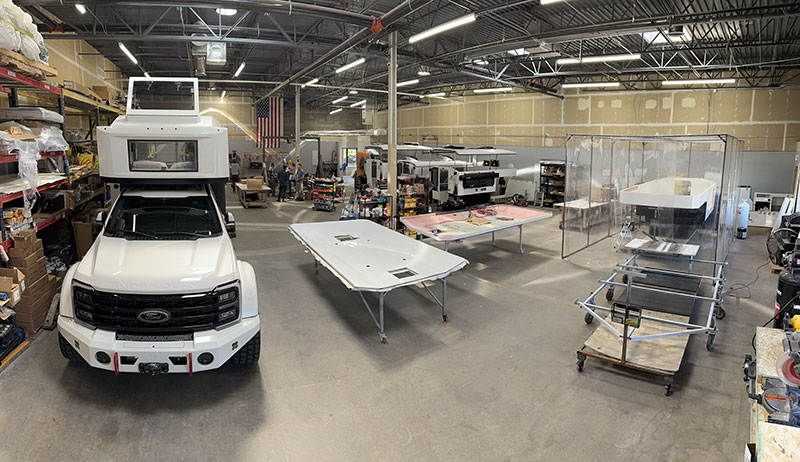
This panoramic photo shows how open Supertramp’s second suite is. On the left side of the image, where Megatron is momentarily planted, is where new campers are delivered to customers.
On the right side is where upper and lower fiberglass roof components are assembled. In the plastic booth is where the final shell prep is completed. Along the back right wall are three stations where camper builds are completed. Behind that is an open office space for management.
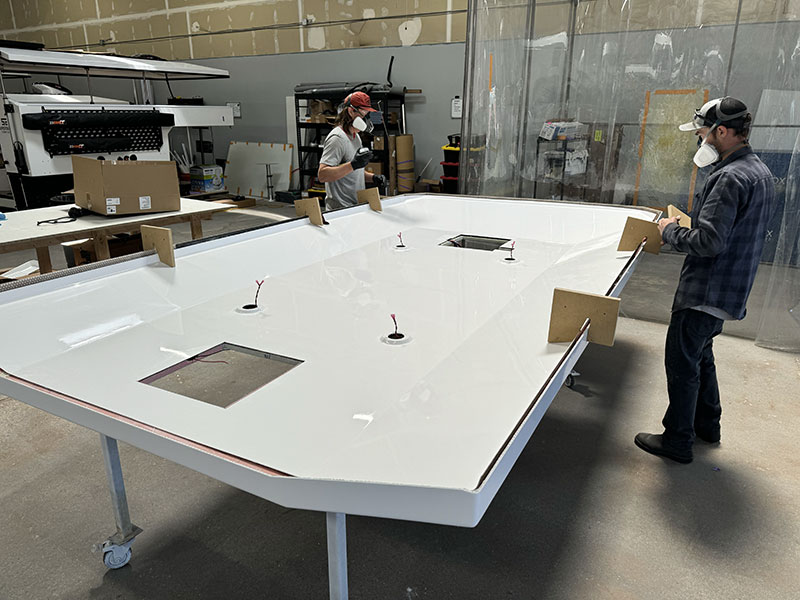
And here’s another place where I encountered Supertramp’s “Secret Sauce”.
It’s no secret that the Flagship LT roof consists of two infusion-fiberglass components; the exterior roof and the interior ceiling. It’s no secret that these two infusion-fiberglass components have a dedicated wiring harness for lights, fans, and an optional 12-volt air conditioner. And it’s no secret that these two infusion-fiberglass components are assembled into a complete roof.
What is secret is the exact adhesive used and the technique by which that adhesive is applied. As it was explained to me, finding the exact right adhesive and process took an enormous amount of time and effort to perfect. I was allowed to observe under the understanding that no images or adhesive brand names would be shared. That’s top Supertramp secret.
One detail I can share relates to the wood jigs placed around the driver and passenger sides of the assembled roof (shown above). These jigs allow the team to quickly check the fitment and positioning of the two infusion-fiberglass roof components. Without giving anything away, Supertramp’s processes are full of these quick and precise tolerance checks.
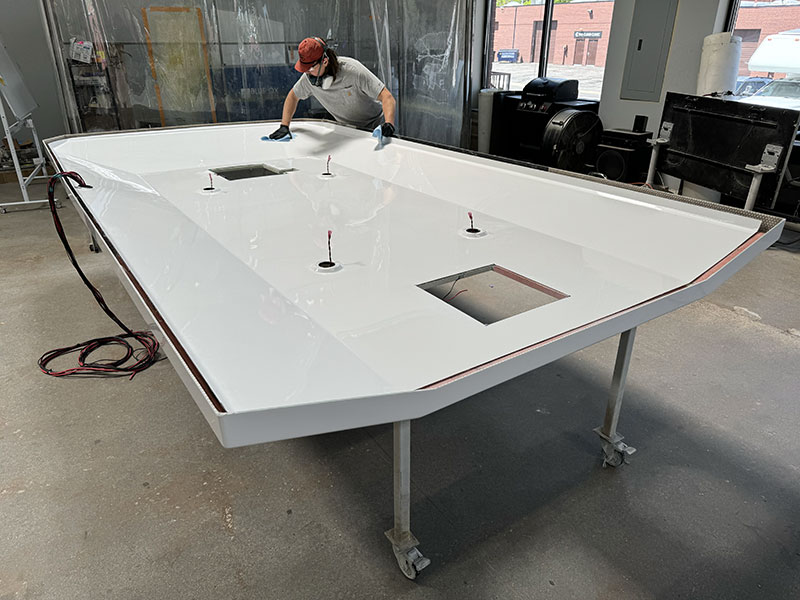
Above: Sully cleans a freshly assembled Flagship LT fiberglass roof
Again, the justification for the effort and cost of infusion-fiberglass reveals itself when you see the final roof form. Not only is this Flagship LT roof lightweight, strong, and seamless, it’s also gorgeous.
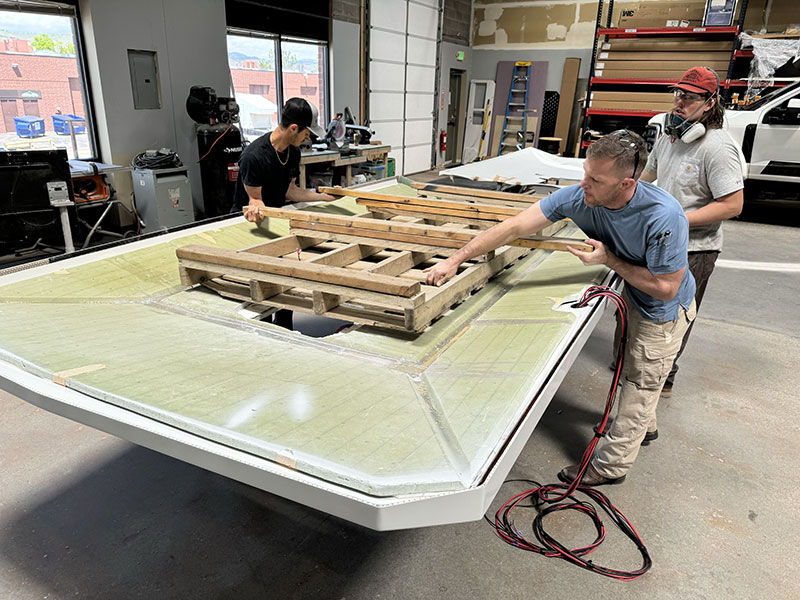
Once all the secret Supertramp Flagship LT roof sauce is done, a series of two weights—the green composite layer on the bottom and the wood palette later on top—are gently laid onto the assembly for overnight curing.
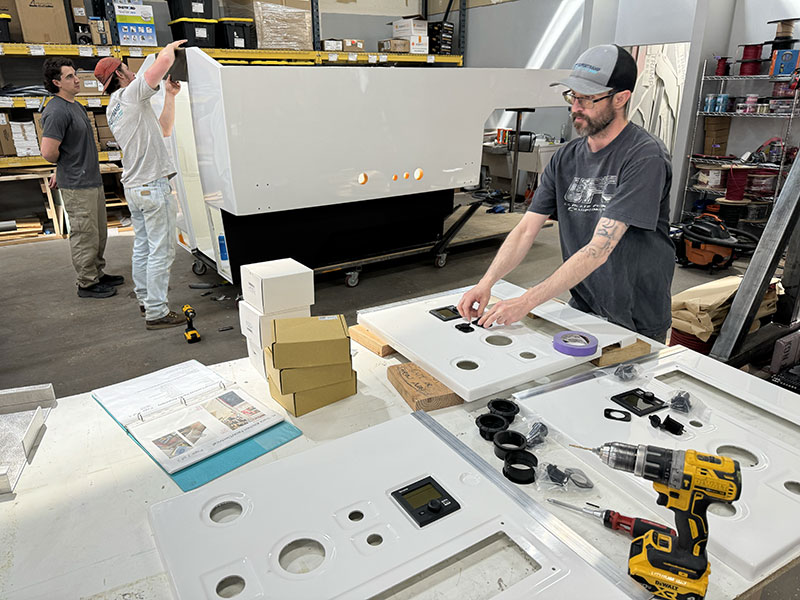
Toward the middle of the suite, Scott was assembling Flagship LT control panels. Note the blue standard operating procedure binder he’s referencing (center left) to ensure every step is completed and the final result meets Supertramp’s specifications.
Behind Scott, Seb, and Jerod are starting to apply a 3M wrap to a Flagship LT lower shell. In addition to three exterior paint color upgrades—Sand Dune Tan, Battleship Grey, and Forest Green—Supertramp offers a 3M wrap option in a huge array of colors. The 3M wrap color in the photo above is Satin Grey.
The other Flagship LT customer orders we saw were in standard white with an exterior decal package in Desert Mesa, Dolomite (gray), or Glacial Valley.
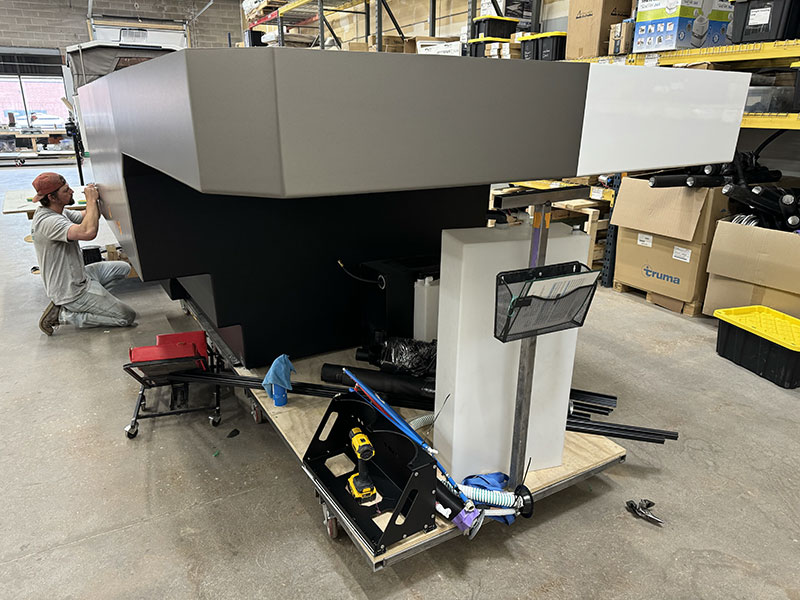
Here you can see the Satin Grey 3M wrap half way completed. The 3M material adds an additional layer of protection to the camper.
I asked Jerod approximately how long a wrap should last and he said it depended on how the camper would be used and stored. In the worst-case scenario, a wrap should last five years or more and can be peeled to reveal the preserved white shell or replaced with a fresh wrap. We would probably opt for the standard white as it’s the best choice for reflecting the summer heat, and it looks fantastic.
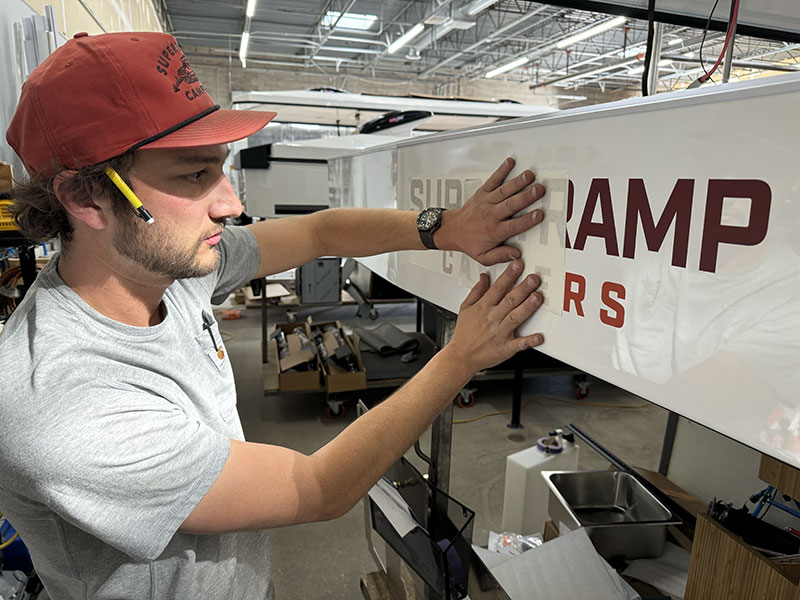
In this image, Matt is placing the Supertramp logo onto the front nose of a Flagship LT. Where most companies eyeball their decal placements, Supertramp measures and places it down to the millimeter. That precision is an important part of the culture at Supertramp.

The side graphics continued the Desert Mesa color scheme selected for the interior. And again, the measuring and care taken ensured the graphics were precisely located. It’s rare to see more than one team member apply decals in a truck camper factory. Here Chris and Matt worked on the side graphics together from start to finish.

Immediately behind the fellas was a refrigerator decorated with decal sections cut from windows and other camper features. Why throw the decals out when you can make a Superfridge?
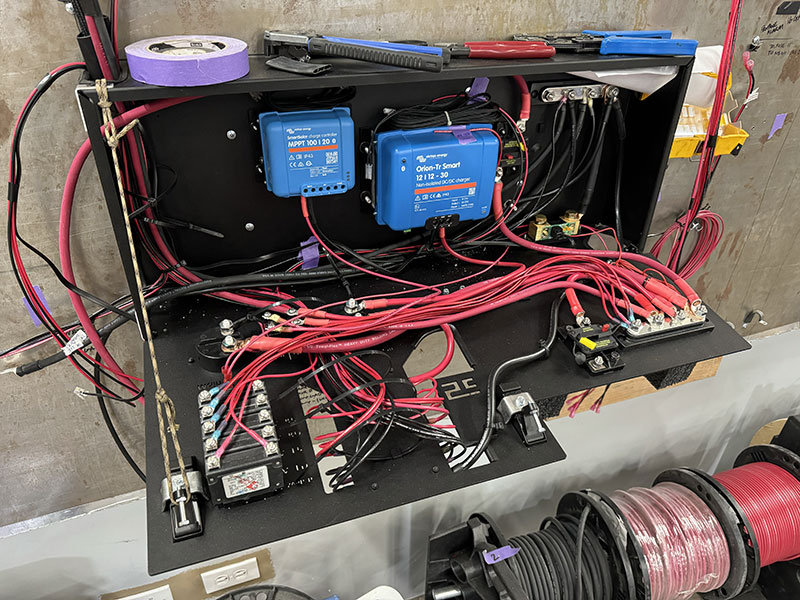
On the back wall of Supertramp’s second suite is where the wiring harness and related electrical components are assembled prior to installation in a camper. On a vertical jig, the electrical wiring is laid out, cut, and terminated into a custom Supertramp electrical box.
In this image, you can see some of the standard Victron Energy components Supertramp employs including a SmartSolar charge controller and Orion-Tr Smart non-isolated DC/DC charger. 1/0 ToughFlex heavy-duty welding cable continues the standard premium choices found throughout the Supertramp electrical system.
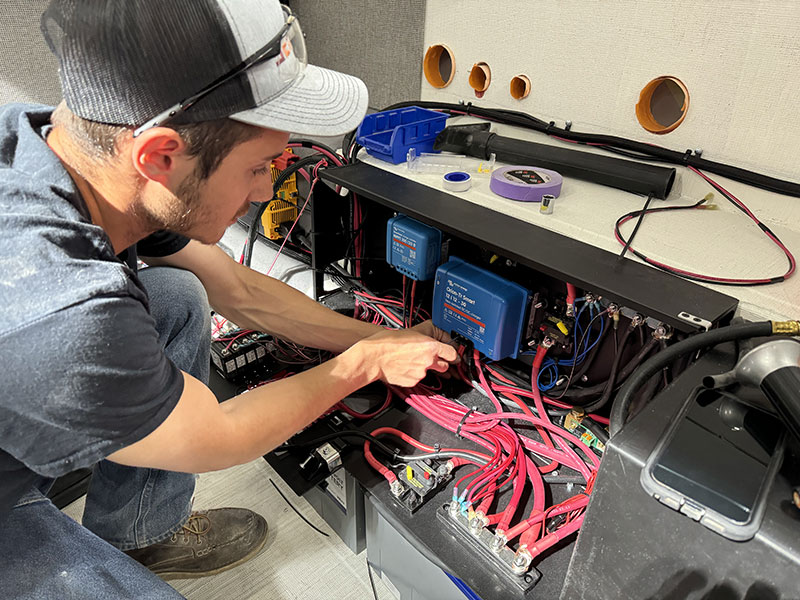
In this photograph, Sam is installing an electrical system into a Flagship LT. By wiring the majority of the electrical box outside the camper, Sam can focus on connecting the standard and optional items outside the electrical box, and quality control.
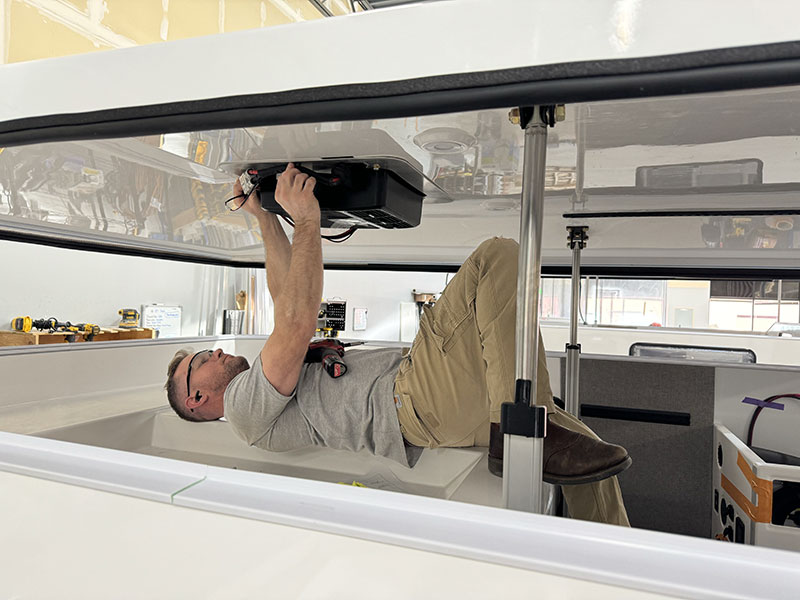
One rule we try to follow in a factory is to stay out of the production team’s way. This isn’t always possible, but we do our best to minimize disruption during our observations and photography. As you might imagine, this gets challenging as you get toward the end of production and people are working inside campers.
We were able to capture a few steps as the final finishing team installed components and completed the campers in production. In the picture above you see Jordan installing an optional 12-volt air conditioner. Rumor has it that Michelangelo painted the Sistine Chapel in a similar position.
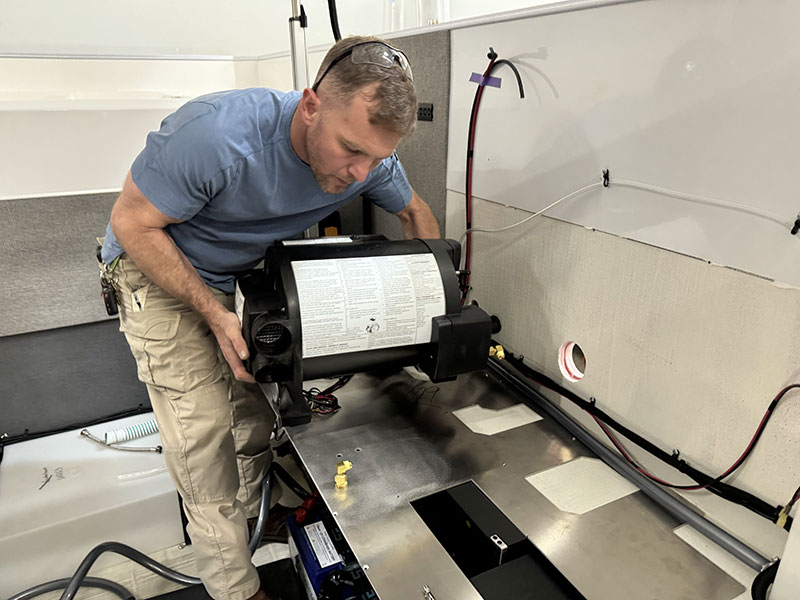
We also observed Jordan installing an optional Truma Combi Eco Plus. The Truma unit efficiently combines the function of a furnace and a water heater.
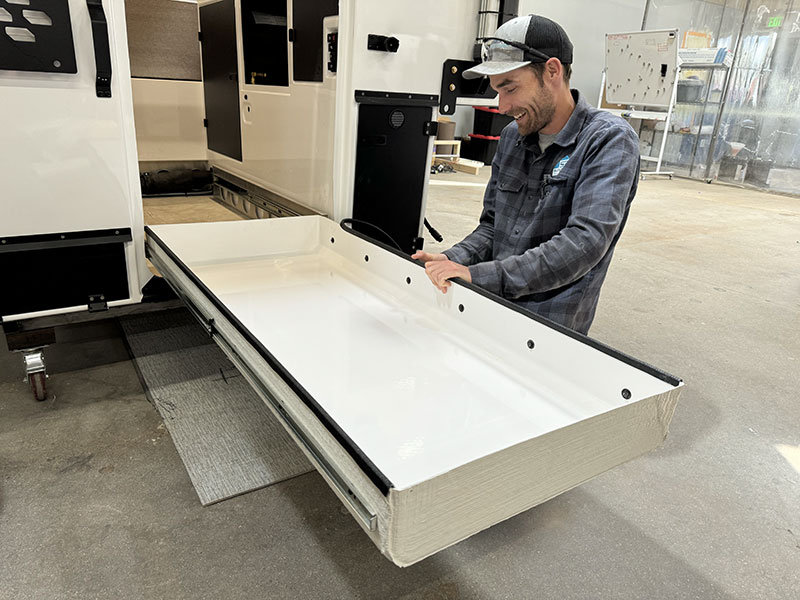
Supertramp has done an exceptional job of designing and specifying every aspect of their build, but their campers are still ultimately handmade. That means every camper undergoes a series of quality control checks and adjustments to make sure every aspect is up to Supertramp expectations.
Here we see Justin installing the protective edge trim on a Flagship LT slide-out tray. Before this picture was taken, he dialed in a few adjustments to the slide-out drawer mechanism.
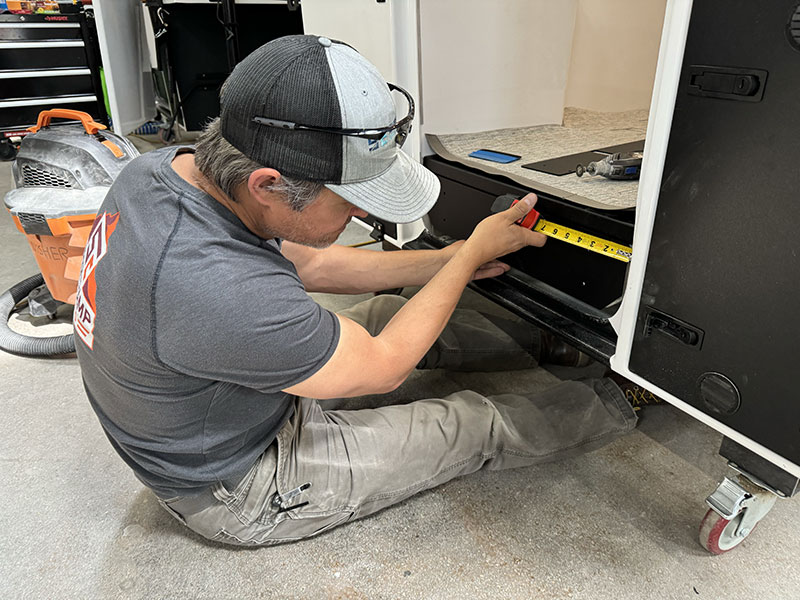
Phil later installed a black faceplate and lock mechanism on the slide-out tray and double-checked the tolerances.
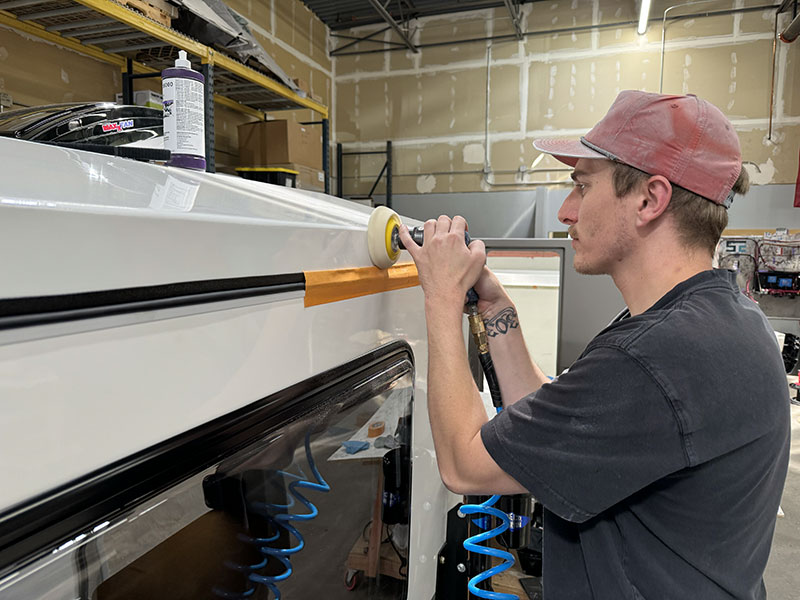
The day before our departure, a completed 2024 Supertramp Flagship LT was being delivered to its new owner. During the final inspection, a minor blemish was found on the roof finish.
To buff it out, Adrian was called up from the first Supertramp suite. From this observation, and many others, this is a team that doesn’t let anything slide. If something isn’t right about a camper, it doesn’t get delivered.
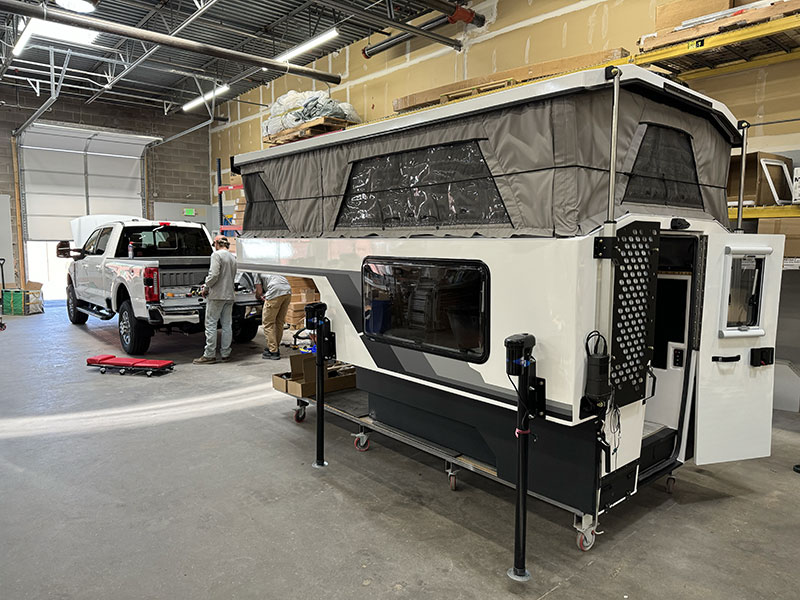
Here’s that same camper the following morning after the final inspections have been passed. The customer has already stopped in, dropped off their truck, and headed out to Golden for breakfast. When they return, the truck wiring will be completed and the camper will be loaded up and ready to go camping.

Above: Pablo chills out beside the Megatron. Not too shabby for a dog’s life.
At the heart of Supertramp is a simultaneously fun and serious team-first culture that embraces not just the skills and dedication of their employees, but their real-world needs. That translates to everything from open opportunities for flextime and overtime to allowing employees to bring their well-behaved dogs to work.
In their brand introduction article last November, Kelsey told us that they hire based on character more than skillset. We saw the result of that focus everywhere at Supertramp. The positive vibes and team spirit are truly palpable. Most impressively, the team members went out of their way to tell us how much they loved working at Supertramp.
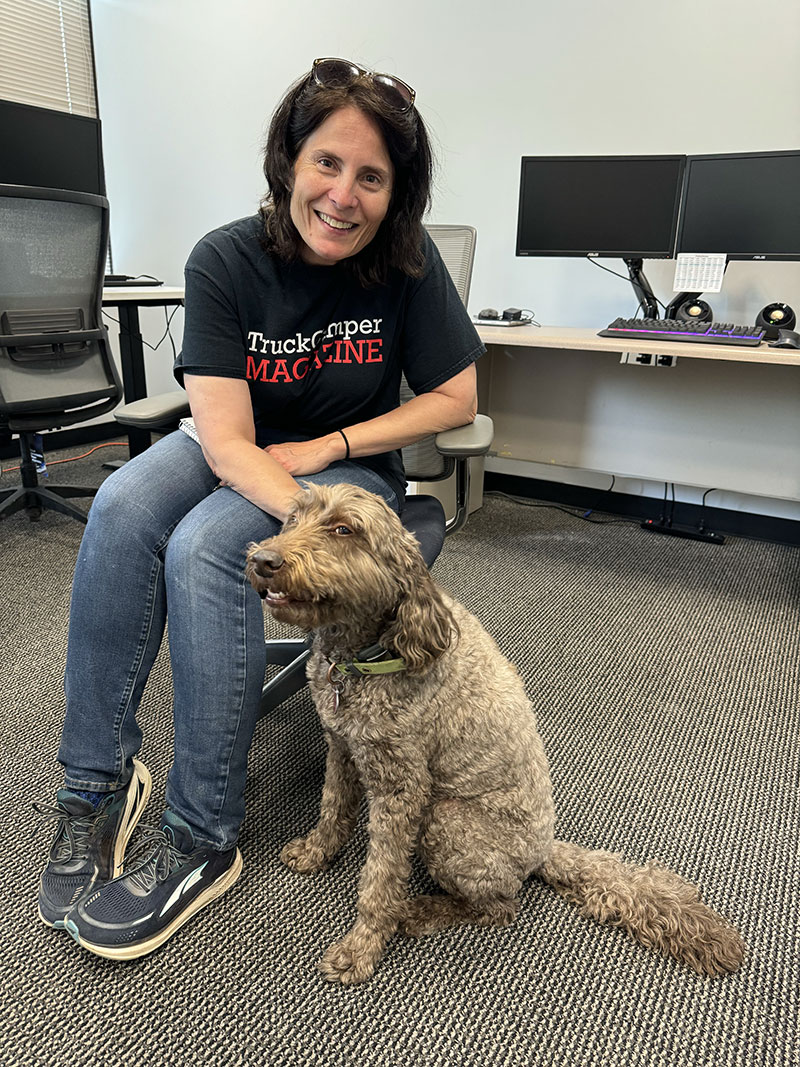
Even the dogs seemed to beam with positive energy. I mean how awesome it must be to go to work every day with your owner instead of being left at home. It’s no wonder Grizz is smiling with Angela in this photo.
If you asked us to reveal what Supertramp’s ‘Secret Sauce’ is, you might be surprised that we wouldn’t mention their vacuum-infused fiberglass or proprietary assembly techniques. While these aspects of their manufacturing process are what the leadership team asked us not to photograph or publish, they’re not what we believe Supertramp’s ‘Secret Sauce’ truly is.
The real Supertramp ’Secret Sauce’ is the incredible young team they’ve put together, the inspired mission they’re focused on, and the unmistakably positive culture Keith and Kelsey have instilled at their company. It was heartwarming and exciting to see, experience, and be around. And it’s not much of a leap to imagine how all that positive energy and team commitment makes its way into Supertramp’s products. It absolutely does.
If you’re considering a Supertramp camper, I have only one recommendation. Contact the Supertramp factory and take a guided tour. While you won’t be permitted to take photographs, the Supertramp team will show you what they consider to be their ‘Secret Sauce’. And while you’re there, you’ll also experience what we believe to be their true Supertramp strength—the team behind every camper. Between the two, it’s quite the combination.
For more information about Supertramp Campers, visit their website at supertrampcampers.com. Click here to request a free Supertramp brochure.
